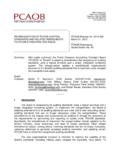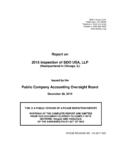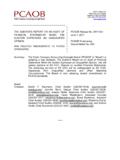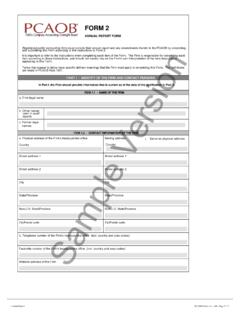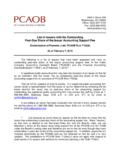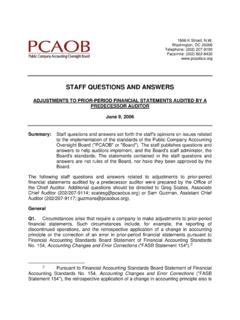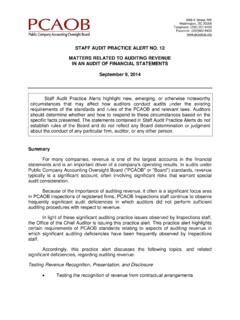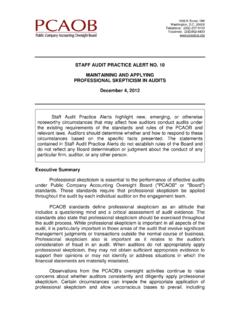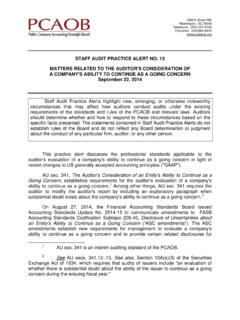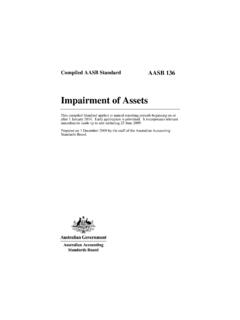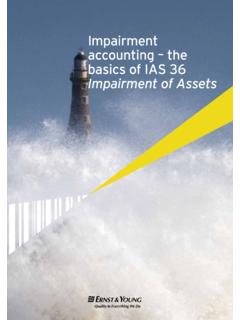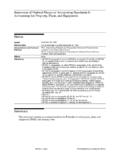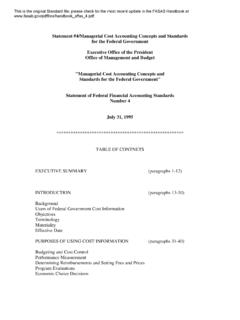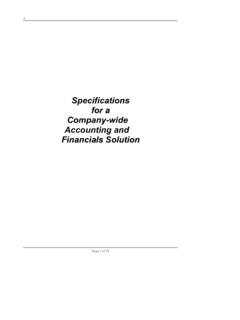Transcription of STAFF AUDIT PRACTICE ALERT NO 8 - PCAOB
1 1666 K Street NW Washington, DC 20006 Telephone: (202) 207-9100 Facsimile: (202) 862-8430 STAFF AUDIT PRACTICE ALERT NO. 15 MATTERS RELATED TO AUDITING REVENUE FROM CONTRACTS WITH CUSTOMERS October 5, 2017 STAFF AUDIT PRACTICE Alerts highlight new, emerging, or otherwise noteworthy circumstances that may affect how auditors conduct audits under the existing requirements of the standards and rules of the PCAOB and relevant laws. Auditors should determine whether and how to respond to these circumstances based on the specific facts presented. The statements contained in STAFF AUDIT PRACTICE Alerts do not establish rules of the Board and do not reflect any Board determination or judgment about the conduct of any particular firm, auditor, or any other person. Introduction This PRACTICE ALERT is being issued to discuss certain significant matters relating to the application of Public Company Accounting Oversight Board (" PCAOB ") standards relevant to auditing the implementation of the new accounting standard for revenue from contracts with customers.
2 This PRACTICE ALERT is intended to facilitate auditors' consideration of these matters in interim reviews of issuers and year-end audits of issuers and brokers and dealers. For many companies, revenue is one of the largest accounts in the financial statements and is an important driver of operating results. In audits performed in accordance with PCAOB standards , revenue typically is a significant account, often involving significant risks that warrant special AUDIT consideration. The Financial Accounting standards Board ("FASB") has issued a new accounting standard, Revenue from Contracts with The new revenue 1 See FASB Accounting standards Update ("ASU") No. 2014-09, Revenue from Contracts with Customers (Topic 606) (May 2014) ("FASB ASU 2014-09"), as codified in FASB Accounting standards Codification ("ASC") Topic 606, Revenue from Contracts with Customers, and additional ASUs that link to the transition guidance in FASB ASC paragraph 606-10-65-1 (the "new revenue standard").
3 Additionally, the International Accounting standards Board ("IASB") has issued International Financial Reporting Standard 15, Revenue from Contracts with Customers, which is substantially STAFF AUDIT PRACTICE ALERT No. 15 October 5, 2017 Page 2 standard replaces most industry-specific revenue recognition requirements in GAAP with a new principles-based, five-step revenue recognition model. It also requires new disclosures, such as qualitative and quantitative information about revenue recognized from contracts with customers (including disaggregated revenue, contract balances, and performance obligations) and significant judgments and changes in judgments. The new revenue standard also specifies, among other things, the accounting and disclosure for some costs to obtain or fulfill a contract with a As companies implement the new revenue standard, they may need to change existing (or develop new) systems, processes, and controls used to gather and archive contract data, make required estimates, and provide required Inadequate or ineffective design or implementation of changes to systems, processes, and controls can pose heightened risks of material misstatement, including the risks of material misstatement due to fraud ("fraud risks").
4 This PRACTICE ALERT highlights certain requirements of PCAOB standards that are relevant to auditors' consideration of companies' implementation of the new revenue standard in upcoming interim reviews and year-end It discusses (a) auditing management s transition disclosures in the notes to the financial statements, (b) auditing transition adjustments, (c) considering internal control over financial reporting, (d) identifying and assessing fraud risks, (e) evaluating whether revenue is recognized in conformity with the applicable financial reporting framework, and (f) evaluating whether the financial statements include the required disclosures regarding converged with generally accepted accounting principles (" GAAP").
5 The references to GAAP in this PRACTICE ALERT are not intended to identify all relevant ASUs or ASC Topics. 2 See FASB ASU 2014-09, Summary. 3 See, , FASB ASU 2014-09, paragraph BC486. 4 The auditing matters discussed in this PRACTICE ALERT are relevant to the auditor's consideration of implementation of the new revenue standard issued by both the FASB and IASB. 5 While this PRACTICE ALERT highlights certain areas, it is not intended to identify all areas that might affect AUDIT risk arising from the implementation of the new revenue standard, nor is it a substitute for the relevant auditing standards . This PRACTICE ALERT does not change auditors' responsibilities; all audits of issuers and brokers and dealers must be conducted in accordance with the standards of the PCAOB . Certain matters included in this PRACTICE ALERT have been the subject of previous inspection findings, as STAFF AUDIT PRACTICE ALERT No.
6 15 October 5, 2017 Page 3 Auditing Management's Transition Disclosures in the Notes to the Financial Statements PCAOB standards require auditors to perform procedures to identify and assess the risks of material misstatement of the financial statements, including consideration of the risk of omitted, incomplete, or inaccurate Additionally, auditors are required to perform substantive procedures to test the relevant assertions of significant financial statement This includes transition disclosures8 regarding the new revenue standard when presented in the notes to the financial statements (including discussed in more detail in Maintaining and Applying Professional Skepticism in Audits, STAFF AUDIT PRACTICE ALERT No. 10 (Dec. 4, 2012) (" PRACTICE ALERT No.))
7 10"); Considerations For Audits of Internal Control Over Financial Reporting, STAFF AUDIT PRACTICE ALERT No. 11 (Oct. 24, 2013) (" PRACTICE ALERT No. 11"); and Matters Related to Auditing Revenue in an AUDIT of Financial Statements, STAFF AUDIT PRACTICE ALERT No. 12 (Sept. 9, 2014) (" PRACTICE ALERT No. 12"). 6 See, , paragraphs .49, .52, and .67 of AS 2110, Identifying and Assessing Risks of Material Misstatement. 7 See paragraph .36 of AS 2301, The Auditor's Responses to the Risks of Material Misstatement. 8 See Securities and Exchange Commission ("SEC") STAFF Accounting Bulletin No. 74 (codified in Topic ), Disclosure of the Impact That Recently Issued Accounting standards Will Have on the Financial Statements of the Registrant When Adopted in a Future Period (Dec. 30, 1987), which provides the SEC STAFF 's view that a registrant should evaluate ASUs that have not yet been adopted to determine the appropriate financial statement disclosures about the potential material effects of those ASUs on the financial statements when adopted.
8 In this PRACTICE ALERT , such disclosures in the notes to the financial statements are referred to as "transition disclosures." See also FASB ASC Topic 250, Accounting Changes and Error Corrections, paragraph 10-S99-6, SEC STAFF Announcement: Disclosure of the Impact That Recently Issued Accounting standards Will Have on the Financial Statements of a Registrant When Such standards Are Adopted in a Future Period (in accordance with STAFF Accounting Bulletin [SAB] Topic ). This guidance also applies to transition disclosures related to FASB ASU No. 2016-02, Leases (Topic 842) (Feb. 2016); and FASB ASU No. 2016-13, Financial Instruments Credit Losses (Topic 326): Measurement of Credit Losses on Financial Instruments (June 2016). STAFF AUDIT PRACTICE ALERT No. 15 October 5, 2017 Page 4 when the transition disclosure asserts that the impact of the standard is not expected to be material to the financial statements).
9 9 Auditors are required to evaluate whether the financial statements contain the information essential for a fair presentation of the financial statements in conformity with the applicable financial reporting This includes evaluating the company's transition disclosures regarding the new revenue standard and, if such disclosures are omitted, incomplete, or inaccurate, evaluating the effect on the financial statements and auditor's report. Additionally, in an integrated AUDIT , the auditor should test controls that are important to the auditor's conclusion about whether the company's controls sufficiently address the assessed risk of material misstatement to the relevant assertions of significant disclosures, including transition Auditors also have responsibilities under PCAOB standards for performing procedures with respect to transition disclosures presented in interim financial The objective of the auditor s review of interim financial information is to provide the auditor with a basis for communicating whether he or she is aware of any material modifications that should be made to the interim financial information for it to conform with generally accepted accounting The auditor's procedures in such a review are generally limited to analytical procedures, inquiries.
10 And other 9 The SEC's Chief Accountant has reminded companies that the basis of any statement in disclosures that the impact of the new revenue standard is immaterial should reflect consideration of the anticipated effect of the full scope of the standard, which covers recognition, measurement, presentation, and disclosure for revenue transactions. See Wesley R. Bricker, SEC Chief Accountant, Remarks before the Annual Life Sciences Accounting & Reporting Congress: "Advancing Effective Internal Control and Credible Financial Reporting" (Mar. 21, 2017). 10 See paragraph .31 of AS 2810, Evaluating AUDIT Results. 11 See paragraph .39 of AS 2201, An AUDIT of Internal Control Over Financial Reporting That Is Integrated with An AUDIT of Financial Statements. 12 See paragraph .02 of AS 4105, Reviews of Interim Financial Information, which defines the term "interim financial information" to mean "financial information or statements covering a period less than a full year or for a 12-month period ending on a date other than the entity's fiscal year end.
